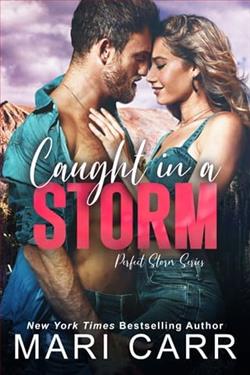Page 47 of The Sky Beneath Us
‘There’s still so much we don’t know about the medicinal properties some plants may hold,’ he continues, waving his arms, his passion for his work evident as he gets into his stride. ‘Take the example of the Madagascar periwinkle. It was once used in traditional medicine and when scientists researched it further, they discovered it contained two compounds – vinblastine and vincristine – that reduce the number of white blood cells in the body. Those alkaloids have been developed to provide a key substance used in chemotherapy for the treatment of various cancers. It revolutionised the treatment ofchildhood leukaemia, in particular. Just imagine how many young lives have been saved by that little plant. Just imagine how many more such discoveries could be out there, waiting to be made.’
‘So would you be interested in talking to people who can tell you more about the plants they use in their traditional medicines?’ I ask.
‘Certainly,’ he replies.
I show him a photo I’d taken of theTiarellathat Pema had picked to make the compress for Themi’s arthritis.
‘This is exactly the kind of thing we want,’ he says. ‘Modern-day plant hunters are citizen scientists, taking photos on their phones rather than digging up specimens. Can you send this photo to me? And put me in touch with your cousin Pema? I’d like to know more about the other plants they use there too.’
We talk for ages, the tea growing cold in our cups, as Martin tells me more about the work he’s been involved in and asks about my trip to Phortse.
‘One thing I don’t understand is where the rest of Violet’s specimens have got to,’ I say. ‘Why are the species sent back by plant hunters like Frank Kingdon Ward recorded out there in the gardens, but there’s nothing of hers?’
He nods. ‘It’s a terrible loss. As you know, the Herbarium was once housed in the Caledonian Hall. But, attractive though it is as a building, it was a bit of a white elephant, never built for scientific purposes. Back in the day, it would have been a damp and airless place to work. It had a terrible old heating system using paraffin oil, which generated so much water vapour it ran down the walls and black mildew grew everywhere. The specimens sent back by Violet were among a significant part of the collection that was lost due to that dampness. Seeds and plant material simply rotted. It’s awful, isn’t it, she went to all that trouble to collect them and send back to the Botanics here in Edinburgh, only for them to end upbeing destroyed. Thankfully, nowadays we have far better methods of preservation, and the move to the new building here helped too.
‘One of the things I want to do, when I have the time,’ he continues, ‘is to go through Violet’s papers in the archive and see what’s there. It would be good to cross-reference the missing species with those on our main Flora of Nepal database. She may have made some important findings, even though it’s such a tragedy that they will have been lost now.’
‘I have some more photos on my phone,’ I tell him, holding it out for him to see. ‘I took them when Violet’s daughter, Themi, showed me the Valley of Flowers and some of the plants she remembers her mother being especially interested in conserving. Perhaps they might give you an idea too, if you can link them to the notes you have from her.’
He reaches out an angular arm to take my phone from me, nearly spilling cold tea over the table in his excitement as he leans in to get a closer look. ‘Is thatMeconopsis horridula? And what’s that primula growing by the stream? I don’t recognise the exact form ... Well, your photos are certainly a great start, Daisy. Would you be happy to send copies to me? It’s just a shame we don’t have a pictorial record of everything else she discovered.’
I nod slowly. Then I say, ‘What if there were some drawings? Would they be of use? And what if there were some seeds? Do you think they might still be viable today?’
‘That depends. They’d need to have been kept in the right conditions. Cool, dry and dark. And, above all, safe from the damp.’
And then, when I tell him about my discovery of the sketches and the neatly labelled jars of seeds in the waterproof plastic drum that sits in the corner of Themi’s house, the tea finally does go everywhere as he sends his cup flying.
A smile spreads over his face as I describe what I remember seeing. And I smile too, as the realisation dawns that Violet’s legacy may still hold the promise of new life. Thanks to her foresight, she may have saved some of the rarest species of Himalayan plants for generations to come.
Daisy – April 2023
The Hillary Bridge stretches away before us, festooned in its streamers of prayer flags. We ease our rucksacks from our shoulders while we wait for a lengthy train of yaks to plod their way across it towards us, setting it swaying, and Mara grins broadly. ‘It’s so awesome, Mum. I still can’t believe you did this trek on your own.’
I laugh, stepping aside to allow the porters following the yaks to pass by with their broad bamboo baskets. ‘Well, I did have the help of a number one best Sherpa, of course.’
Tashi nods, acknowledging the compliment, and smiles benevolently. ‘Your mum, she do twice this distance for her trek, no worry. Strong as a yak,’ he tells Mara.
‘I’ll take that as the highest praise,’ I say, as we shoulder our packs once more and step out on to the bridge. ‘Yaks are the most wonderful creatures.’
We’re on our way to Phortse, where Sorcha will be waiting for us. She’s been living at Tashi and Dipa’s lodge for a month now, carrying out research for her undergraduate dissertation on the effects of climate change in the Khumbu valley.
Mara almost skips across the bridge. I follow a little more sedately, pausing in the centre to feel the wind sweep over my face and scatter my thoughts into the sky beneath us, mingling with the prayers from the fluttering flags. Far below, the milky-turquoiseriver winds its way through the mountains. And then I walk onwards, the bridge bouncing beneath my feet as I head for the other side.
‘I wonder how Sorcha managed to cross that,’ says Mara as she snaps some photos, looking back the way we’ve come. ‘She’s never had much of a head for heights.’
‘She do okay,’ replies Tashi. ‘Sonam took her pack, led the way. I walk behind her. No worry.’ Mara and I exchange a knowing glance. Sonam’s name seems to feature rather often in Sorcha’s messages, and he’s apparently been in no great rush to return to Kathmandu while she’s been in the village.
‘You ready for Namche Bazaar tonight and tomorrow, Miss Mara?’ Tashi asks. ‘Many young people there, now climbing season open again. Irish pub, fancy coffee, nightclub?’
‘I think I’ll just be looking forward to my supper and a good night’s sleep by the time we get there if the rest of the way’s as steep as this,’ she replies, hands on her hips as she puffs her way up the path.
‘Just put one foot in front of the other, slowly, slowly. You get there, no worry.’
The familiar mantra buoys my spirits, helping me on my way. The trek seems easier this time. Perhaps it’s psychological – the path is a familiar one and I know it’s possible for me to make it. Or perhaps it’s the fact that my heart is so much lighter this time around, even if my pack is heavier, full as it is with gifts for my friends.
It’s taken three years to be able to travel freely again and return to the Khumbu. Three long years for the world to get the pandemic under some sort of control. Miracles have been worked, with vaccines being developed and programmes rolled out, with countries working together to try to halt the spread of the virus. But the pain and the loss and the fear have left their legacy too. Livelihoods have been lost, mental health has suffered, and the cruel illness continuesto kill the vulnerable and the elderly. My mum’s never regained her old strength after she had Covid and then it took Davy from us. Her exhaustion has meant she’s not been able to make the trip with us. Three years ago, she might have managed it, despite her age. But now she’s tired all the time, and her worn-out lungs make her susceptible to any further infections, so she can’t risk international travel. It’s hard to tell whether it’s her physical or her mental strength that’s been most affected. Either way, the virus has had a lasting effect on her. Jack’s stayed behind at Aultbea to look after her, as well as Elspeth, and he’s promised Mara he’ll look after her garden, too, while she’s away.
The music school has reopened now, so that’ll be keeping them all busy. It’s a consolation to know the rooms of the big house resound once again with the sounds of practice and performance.















